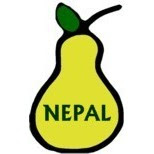Photo — Rajan Kumar Nepali sits with his daughter in his house in Ranibari, Kathmandu. He said his daughter was wrongfully placed for adoption with an American family who were getting ready to take her to the United States. Image by Anup Kaphle. Nepal, 2011.
ANUP KAPHLE, FOR THE PULITZER CENTER, NEPAL
Published on February 10, 2011
When Rajan Kumar Nepali handed over his two children to a local orphanage in Kathmandu, he never imagined that they would be put up for adoption.
Rajan was a drug-addict. After being unable to cope with his addiction, Maya, his wife, left him and their two children at their ramshackle rented home about a mile west of the bustling city of Kathmandu. In desperation, Rajan decided to send his children to an orphanage, which he said promised to take care of them while he was in a drug rehabilitation center.
“I thought there were women caretakers at the orphanage who would be able to better care for them,” said Rajan. “I didn’t send my children away so that they could be adopted and taken abroad.”
But his three-year-old daughter was put up for adoption by the orphanage and placed with an American couple, a trend that has developed into lucrative business in Nepal because of the adoption fees that come with it. Last year alone, the Nepali government approved the adoptions of 195 children by international parents, 52 of them going to homes in the United States. But following cases like Rajan, where children were wrongfully put up for adoption, the United States government last August suspended adoptions from Nepal, citing rampant corruption in the system.
The abuse of adoption system is not new to Nepal. Following accusations of falsified documents and unregulated orphanages, the Nepali government shut down its international adoption program three years ago. New legislation later in 2008 banned the adoption of street children, required better verification that a child is an orphan, and established an oversight body to regulate existing orphanages. Under its new program, Nepal now allows two kinds of inter-country adoption: orphans and children voluntarily surrendered by their parents.
The U.S. State Department said cases like Rajan’s have exposed flaws in Nepal’s inter-country adoption system. Consequently, the State Department has cancelled its participation in the program and says it will not renew it until Nepal assures all adoptions are legal and ethical.
“We tried for very long time to work with the Nepalese government but they showed no inclination to work with us on this issue,” said Susan Jacobs, special advisor for international children’s issues at the State Department.
Nepali officials mostly defend their new system, but admit that they have problems at the local level, which is where the documents originate. “We have to depend on the local government for the process — police, municipality office and district magistrate officers,” said Sher Jung Karki, under-secretary at the Ministry of Women, Children and Social Welfare.
Another reason the number of adoption scandals has risen is the steep fee that foreigners must pay to orphanages. In an interview with a local orphanage, I learned orphanages can make up to $5,000 per child. Some other orphanages say foreign parents are willing to pay as much as $10,000. This opportunity for easy money led to an increase in the number of orphanages in Nepal, and with limited government oversight, children from the streets and others who had not been volunteered for adoption were put on the adoption market.
With the adoption system currently in limbo, the ones who are suffering are the parents who have already paid the money, have been given the child, but are not allowed to bring the child into the United States until they can prove that child is, in fact, an orphan or legally put up for adoption by the birth parents. In recent weeks, some American parents have been able to bring a Nepali child home, but many children remain stuck in Nepal, awaiting a green light from the U.S. government.
Meanwhile, Rajan and his wife have reunited with both of their children. Rajan said that although the American parents who wanted to adopt his daughter couldn’t do so, they still keep in touch through a pastor at a local church, and occasionally send money to pay for his daughter’s education.
Rajan said he is not against westerners adopting Nepali children. He just wasn’t expecting that those put up for adoption would be his own.
“There are many orphans in Nepal, so maybe it’s good that they get adopted by foreign families, especially those who can’t have children,” he said.
